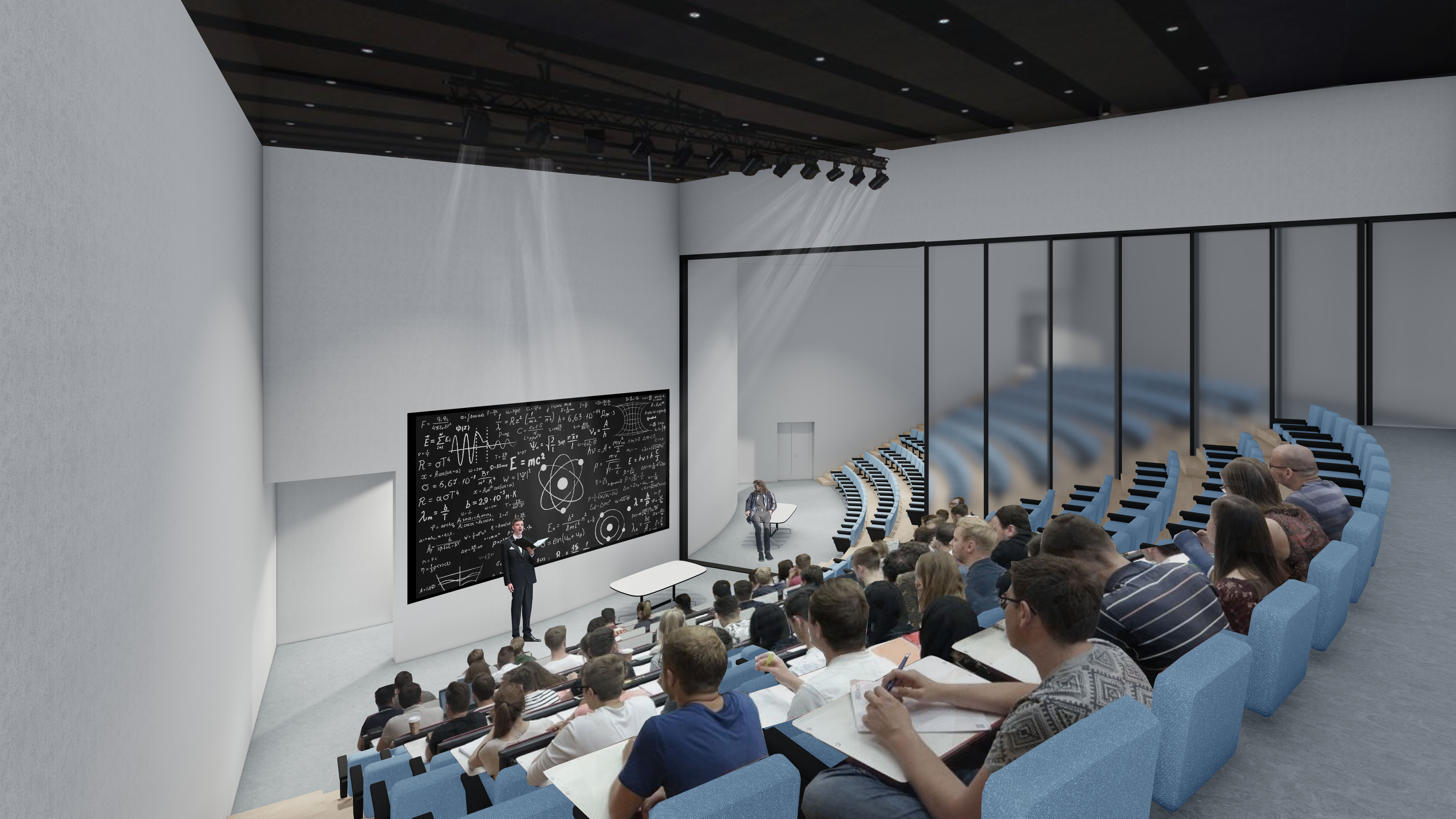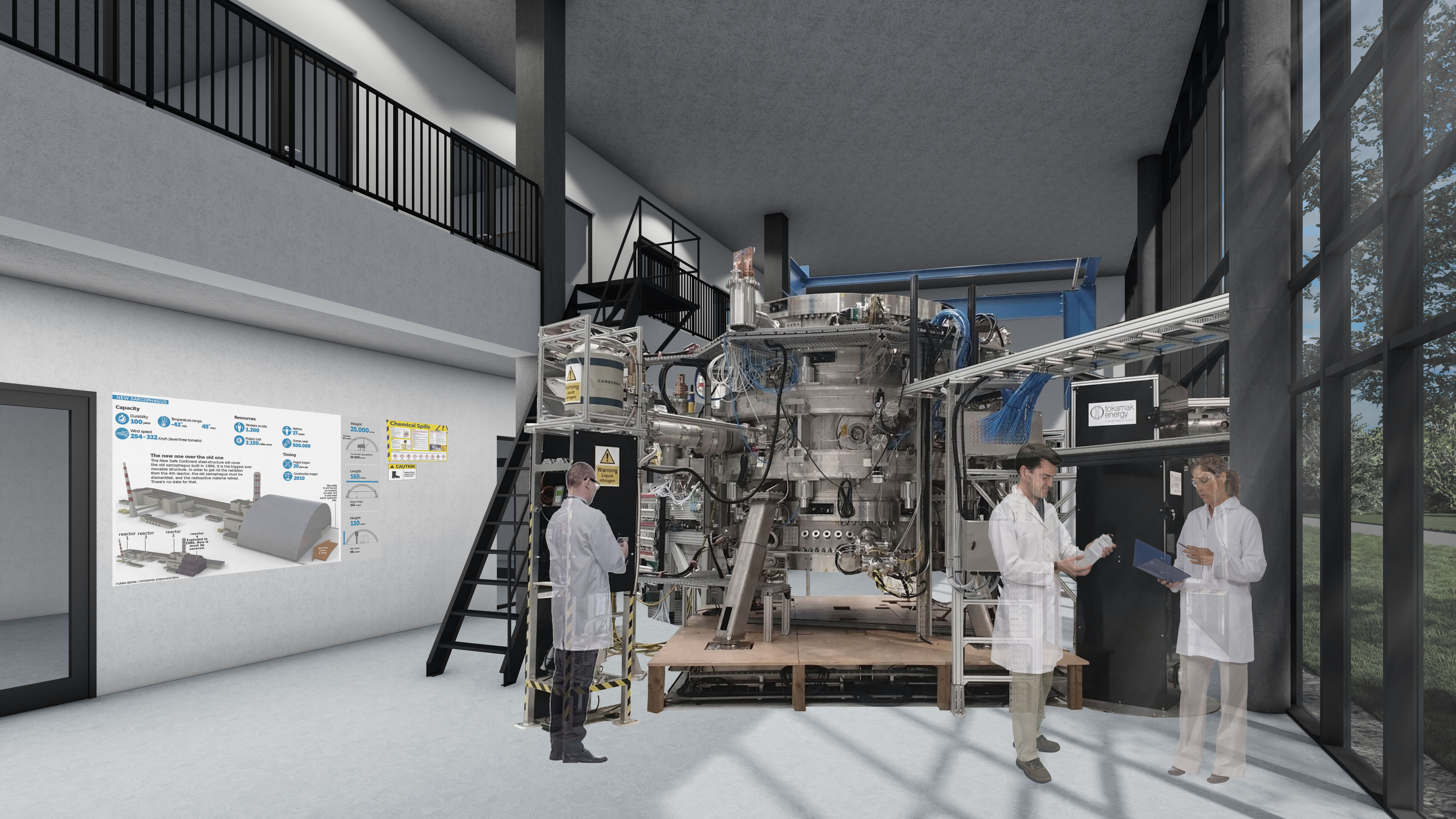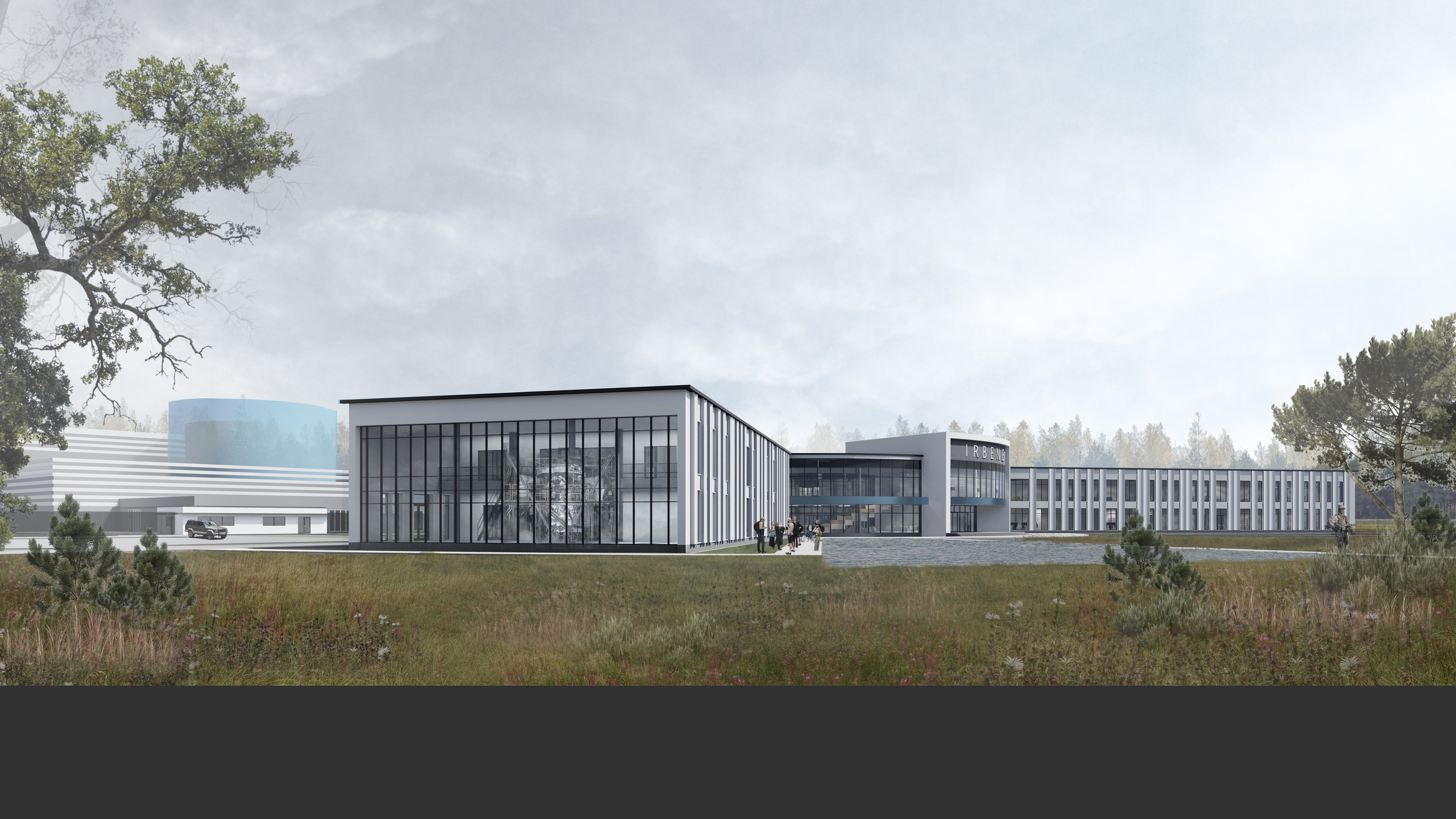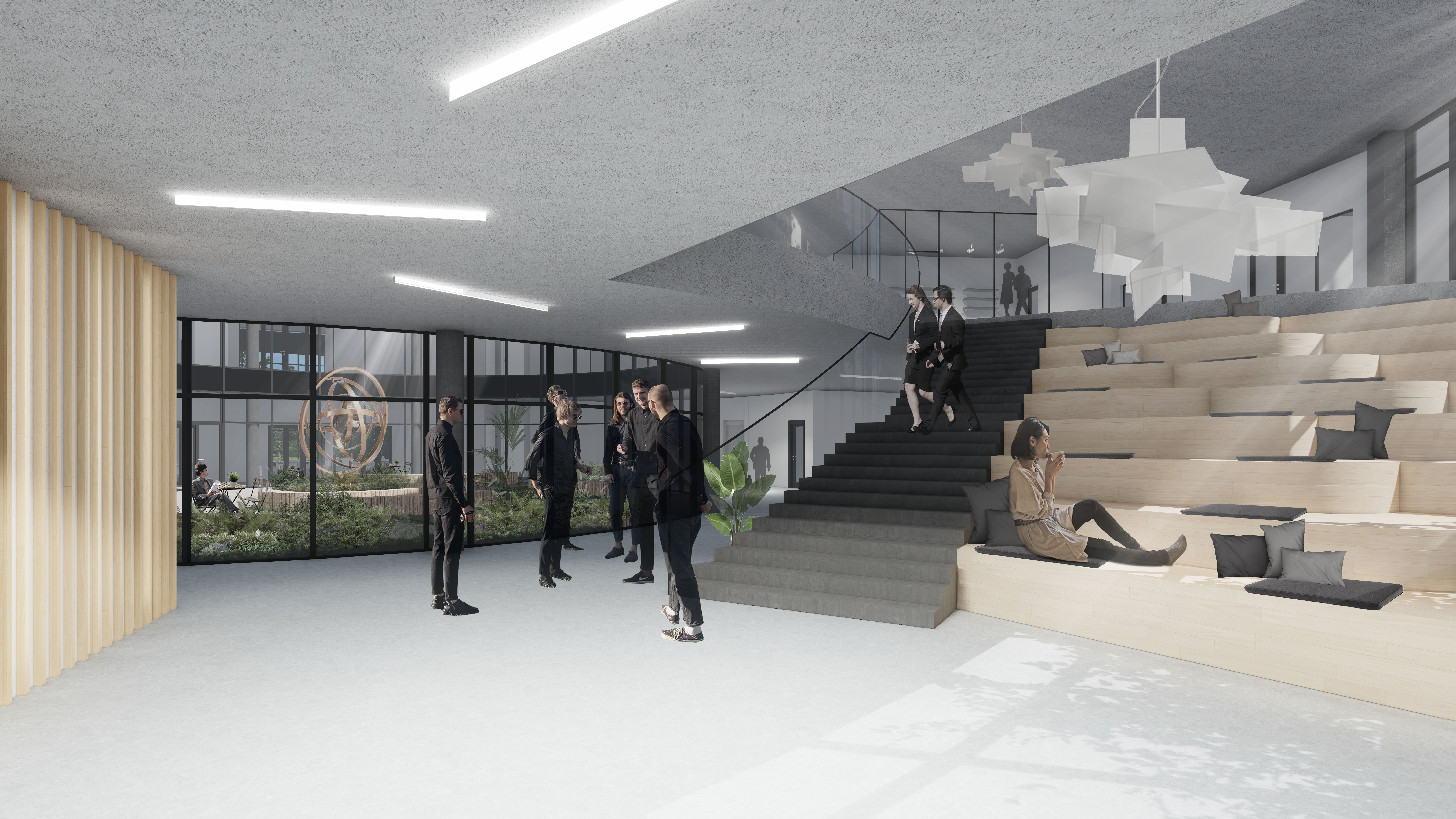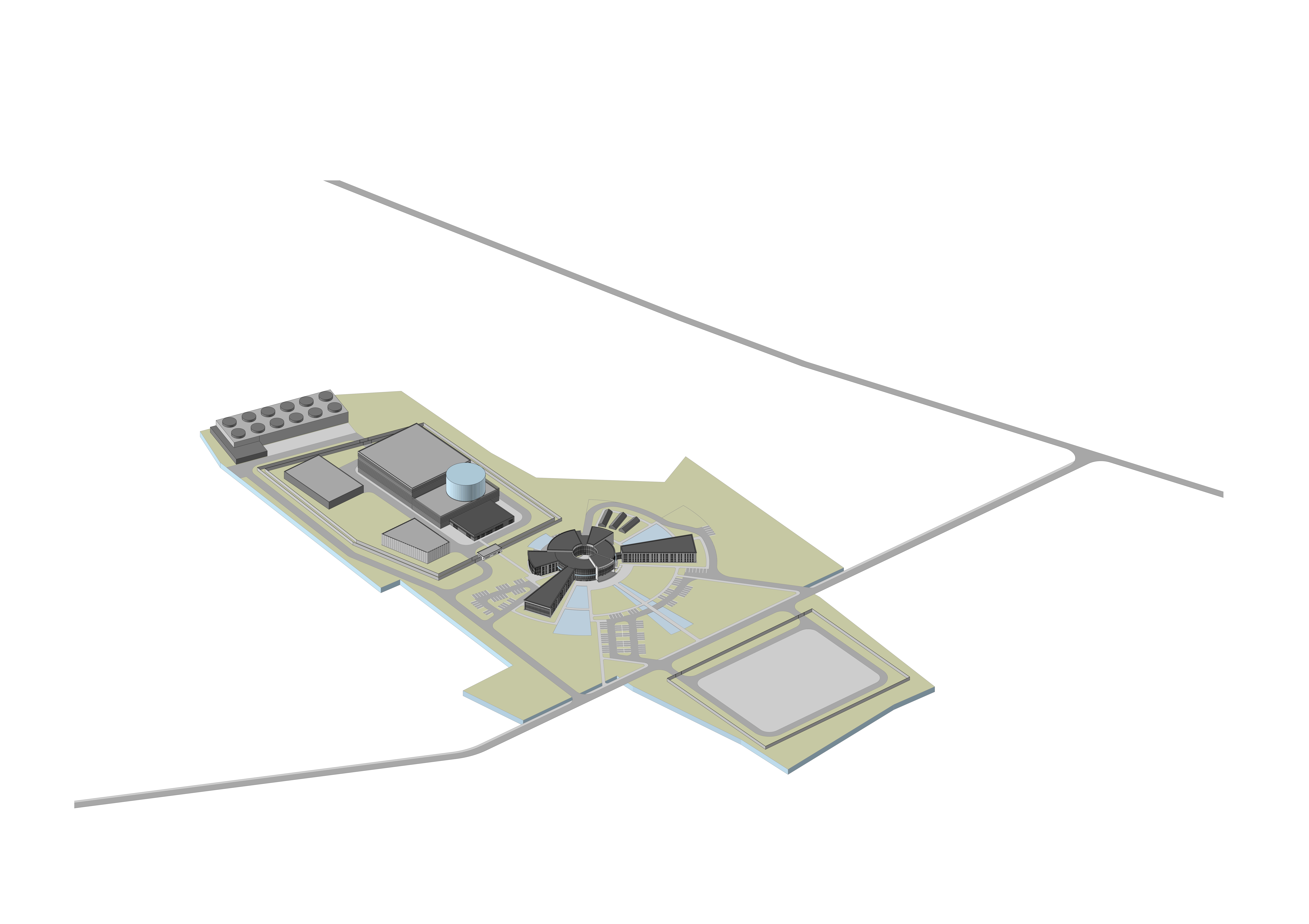Shaping a circular industrial ecosystem and supporting life-cycle thinking
Research Center near the Nuclear Reactor
Nuclear Power Plant in Latvia: Research Center near the Nuclear Reactor
In 2025 the Baltic states are leaving the BRELL power grid. To ensure Latvia’s energy independence, experts suggest a small modular nuclear power plant. The “Irbene” research center is designed to collaborate with a high-security nuclear facility, adding functionality to industrial sites while integrating with the Ventspils International Radio Astronomy Center. Its architecture is inspired by the ionizing radiation symbol, reflecting its connection to advanced energy research.
Latvia
Regional
Kurzeme, Latvia
Mainly rural
It refers to a physical transformation of the built environment (hard investment)
Early concept
No
No
As an individual
The project "Nuclear Power Plant in Latvia – Research Center near the Nuclear Reactor" envisions a nuclear power facility that integrates research, education, and sustainability principles. The project is based on the first part of the masters thesis: Modern Approach to Power Plant Design. Its primary goal is to establish a nuclear energy hub that ensures Latvia’s energy independence while setting an architectural and ecological benchmark for future power plants. The project repurposes an abandoned and degraded territory into a green energy source, providing stable, low-emission electricity. The integration of a research center fosters public engagement, scientific advancement, and industry collaboration.
The target groups include the entire Latvian population, policymakers, energy sector professionals, and researchers. Additionally, the project supports the Kurzeme region by creating employment opportunities and promoting regional development. The design is rooted in multifunctionality, balancing energy production with educational and architectural values.
The project's objectives:
- Providing a sustainable, stable energy source for Latvia.
- Reducing dependence on foreign energy imports.
- Transforming a degraded site into an ecological asset.
- Promoting interdisciplinary research on nuclear energy and sustainability.
- Enhancing public perception of nuclear energy through accessibility and design.
The target groups include the entire Latvian population, policymakers, energy sector professionals, and researchers. Additionally, the project supports the Kurzeme region by creating employment opportunities and promoting regional development. The design is rooted in multifunctionality, balancing energy production with educational and architectural values.
The project's objectives:
- Providing a sustainable, stable energy source for Latvia.
- Reducing dependence on foreign energy imports.
- Transforming a degraded site into an ecological asset.
- Promoting interdisciplinary research on nuclear energy and sustainability.
- Enhancing public perception of nuclear energy through accessibility and design.
Sustainability
Transformation
Engagement
Ecology
Modernity
The project prioritizes sustainability by advocating for nuclear power as one of the lowest CO2-emission energy sources, alongside wind and solar energy. The architectural design minimizes environmental impact through site regeneration and efficient material use. The degraded and heavily soiled Soviet-era village is beyond the possibility of restoration; therefore, this plot was chosen. All the concrete, metal scraps, toxic fluids, and other materials have been absorbed into the ground next to a natural reserve, and this contamination needs to be addressed. Regenerating this area by building a research center alongside a functioning nuclear power plant might seem counterintuitive at first, but once the real safety and purity of nuclear energy are understood, along with its high-efficiency energy generation and minimal environmental footprint, the potential for a bold statement becomes clear.
To complement already green energy created, the plan is utilise cogeneration to repurpose otherwise unused heat, supplying warmth to the research center, on-site greenhouses, and surrounding towns, demonstrating a highly efficient and sustainable energy cycle.
The inclusion of a research center promotes innovation in nuclear safety and energy efficiency, ensuring long-term sustainability while also collaborating with the Ventspils International Radio Astronomy Center in the nearby territory.
To complement already green energy created, the plan is utilise cogeneration to repurpose otherwise unused heat, supplying warmth to the research center, on-site greenhouses, and surrounding towns, demonstrating a highly efficient and sustainable energy cycle.
The inclusion of a research center promotes innovation in nuclear safety and energy efficiency, ensuring long-term sustainability while also collaborating with the Ventspils International Radio Astronomy Center in the nearby territory.
Unlike traditional nuclear plants, which are often isolated and purely functional, this project redefines their architectural potential by integrating a research center that fosters public engagement, scientific collaboration, and education. By creating a space where visitors can learn about nuclear energy through interactive exhibits, guided tours, and transparent communication, the design helps demystify nuclear technology, improving public perception and acceptance. The center also serves as a bridge between industry professionals, students, and the general public, fostering dialogue on the role of nuclear energy in sustainable development.
The project proposal envisions dividing the designed building into four functionally distinct volumes, which are interconnected:
1st wing: Central Building
2nd wing: Nuclear Physics Building
3rd wing: Space Physics Building
4th wing: Nuclear Plant Office Building
Additionally, the incorporation of accessible green spaces and architectural references to the site's history strengthens the connection between the facility and the local community. The integration of water features- open cooling reservoirs- serve both functional and aesthetic purposes, integrating water features that reflect the scientific essence of the facility, enhances the aesthetic and symbolic quality of the space. In this project big role plays the integration of the plant into the surrounding environment, ensuring visual harmony while reducing industrial isolation. Nuclear power plant is a high security building and the proper security measures have to be taken while designing it and the surrounding area. Before the design stage, a deep research has been made in this field, providing safe and secure solution for the needed areas, as well as merging the possible zones, internal and external, with the research center.
The project proposal envisions dividing the designed building into four functionally distinct volumes, which are interconnected:
1st wing: Central Building
2nd wing: Nuclear Physics Building
3rd wing: Space Physics Building
4th wing: Nuclear Plant Office Building
Additionally, the incorporation of accessible green spaces and architectural references to the site's history strengthens the connection between the facility and the local community. The integration of water features- open cooling reservoirs- serve both functional and aesthetic purposes, integrating water features that reflect the scientific essence of the facility, enhances the aesthetic and symbolic quality of the space. In this project big role plays the integration of the plant into the surrounding environment, ensuring visual harmony while reducing industrial isolation. Nuclear power plant is a high security building and the proper security measures have to be taken while designing it and the surrounding area. Before the design stage, a deep research has been made in this field, providing safe and secure solution for the needed areas, as well as merging the possible zones, internal and external, with the research center.
When designing the project, great attention is paid to the accessibility of the environment both indoors and in the surrounding area, based on the principles of universal design. The building and the area are accessible to people with visual, hearing, and mobility impairments, following the environmental accessibility design requirements of the organization “Apeirons.”
Since the area has predominantly flat terrain with minor level differences, this location allows for the creation of an easily accessible environment for people with mobility impairments. The sidewalks are designed not to exceed the maximum regulatory slope as well as the slope specified by the organization “Apeirons.” The widths of the pathways in the area are at least 2 meters, and the paths are made with a firm and non-slip surface.
The main entrance is designed with a three-step elevation, but a ramp with a straight stop area and curbs has been created for access. All evacuation exits have been designed to provide access with relief, ensuring evacuation from the first floor without any level differences. The floor surface throughout the building is level, without obstacles or level differences. Access between floors is provided using one of the four elevators, one in each of the buildings. The stairs are equipped with tactile and contrasting markings on the steps.
The complex includes six restrooms for people with mobility impairments, as well as a hygiene room next to the medical room. The restrooms are equipped with appropriate facilities, and maneuvering space has been considered.
This design fosters a more inclusive society by removing physical barriers and promoting independence for people with disabilities.
Since the area has predominantly flat terrain with minor level differences, this location allows for the creation of an easily accessible environment for people with mobility impairments. The sidewalks are designed not to exceed the maximum regulatory slope as well as the slope specified by the organization “Apeirons.” The widths of the pathways in the area are at least 2 meters, and the paths are made with a firm and non-slip surface.
The main entrance is designed with a three-step elevation, but a ramp with a straight stop area and curbs has been created for access. All evacuation exits have been designed to provide access with relief, ensuring evacuation from the first floor without any level differences. The floor surface throughout the building is level, without obstacles or level differences. Access between floors is provided using one of the four elevators, one in each of the buildings. The stairs are equipped with tactile and contrasting markings on the steps.
The complex includes six restrooms for people with mobility impairments, as well as a hygiene room next to the medical room. The restrooms are equipped with appropriate facilities, and maneuvering space has been considered.
This design fosters a more inclusive society by removing physical barriers and promoting independence for people with disabilities.
Since this project is still in its early stages, there has been limited public involvement in its development. While the project’s author has not directly engaged with the general public on this concept, various surveys on the potential use of nuclear energy in Latvia have been considered during the research and development phase. Additionally, to ensure inclusivity, all proposed indoor and outdoor solutions have been designed in accordance with the guidelines of the organization “Apeirons.”
At the moment the project is in a concept stage, but in the future it could align with a local, national, and European interests by generating local job opportunities, contributing to countries national energy strategy, supporting EU climate goals by promoting low-carbon energy and providing an exemplary model for nuclear energy adoption in other countries
- Architecture and urban planning: Designing an integrated research center that harmonizes with the industrial function of the power plant.
- Energy policy and regulations: Ensuring compliance with international nuclear safety standards.
- Environmental science: Assessing and mitigating potential impacts on surrounding ecosystems.
- Economics: Evaluating financial feasibility and long-term sustainability of nuclear energy investment.
- Public engagement: Developing communication strategies to increase societal acceptance and understanding of nuclear energy.
Collaboration between these disciplines creates a forward-thinking energy facility that sets a new benchmark for nuclear power plant integration into the public sphere.
- Energy policy and regulations: Ensuring compliance with international nuclear safety standards.
- Environmental science: Assessing and mitigating potential impacts on surrounding ecosystems.
- Economics: Evaluating financial feasibility and long-term sustainability of nuclear energy investment.
- Public engagement: Developing communication strategies to increase societal acceptance and understanding of nuclear energy.
Collaboration between these disciplines creates a forward-thinking energy facility that sets a new benchmark for nuclear power plant integration into the public sphere.
This project challenges conventional power plant design by:
- Transforming a nuclear facility into an accessible, multi-use research hub that collaborates with the Ventspils International Radio Astronomy Center, fostering scientific research and technological advancements.
- Utilizing cogeneration to repurpose otherwise unused heat, supplying warmth to the research center, on-site greenhouses, and surrounding towns, demonstrating a highly efficient and sustainable energy cycle.
- Prioritizing sustainable, multifunctional land use over isolated industrial zones, integrating a power plant into an open and accessible environment.
- Incorporating water features that serve as both architectural elements and functional cooling basins, enhancing site aesthetics while supporting the plant’s operational efficiency.
- Integrating nuclear infrastructure with academic and research functions to promote innovation, environmental responsibility, and public engagement in energy solutions.
- Transforming a nuclear facility into an accessible, multi-use research hub that collaborates with the Ventspils International Radio Astronomy Center, fostering scientific research and technological advancements.
- Utilizing cogeneration to repurpose otherwise unused heat, supplying warmth to the research center, on-site greenhouses, and surrounding towns, demonstrating a highly efficient and sustainable energy cycle.
- Prioritizing sustainable, multifunctional land use over isolated industrial zones, integrating a power plant into an open and accessible environment.
- Incorporating water features that serve as both architectural elements and functional cooling basins, enhancing site aesthetics while supporting the plant’s operational efficiency.
- Integrating nuclear infrastructure with academic and research functions to promote innovation, environmental responsibility, and public engagement in energy solutions.
1. Understanding Architectural Differences in Power Plants- each type of power station has unique advantages and challenges, which must be carefully evaluated to determine the best solution for a given location. This study examines major power plant types, analyzing their structures, operational principles, infrastructure challenges, and environmental impact
2. Examining existing power plants worldwide to assess their integration into the surrounding environment, potential for multifunctionality, and overall environmental impact. By analyzing various designs, the study identifies best practices for sustainable and adaptable energy infrastructure.
3. Nuclear power history in Latvia – This section examines the currently applicable as well as the necessary regulatory acts and Latvia's experience in the use of nuclear energy, which resulted in providing recommendations for the construction of a new nuclear power plant in Latvia
4. Selecting the Right Reactor- the most suitable reactor for Latvia is the GE Hitachi BWRX-300, a small modular reactor chosen based on industry research. Its design prioritizes efficiency, safety, and adaptability to local energy needs
5. Gathering Information on the Reactor- understanding integration possibilities with other infrastructure and necessary regulatory compliance
6. Selecting the Right Location- the choice of location is influenced by historical heritage, environmental protection zones, distance from borders and airports, water supply requirements, military zones, and geological conditions
7. Site Analysis- conducting detailed assessments of environmental impact, infrastructure compatibility, historical analysis and accessibility.
8. Developing the Project Concept- establishing a comprehensive framework combining research, architecture, and sustainability to create a power plant that sets new standards for Latvia’s energy future.
2. Examining existing power plants worldwide to assess their integration into the surrounding environment, potential for multifunctionality, and overall environmental impact. By analyzing various designs, the study identifies best practices for sustainable and adaptable energy infrastructure.
3. Nuclear power history in Latvia – This section examines the currently applicable as well as the necessary regulatory acts and Latvia's experience in the use of nuclear energy, which resulted in providing recommendations for the construction of a new nuclear power plant in Latvia
4. Selecting the Right Reactor- the most suitable reactor for Latvia is the GE Hitachi BWRX-300, a small modular reactor chosen based on industry research. Its design prioritizes efficiency, safety, and adaptability to local energy needs
5. Gathering Information on the Reactor- understanding integration possibilities with other infrastructure and necessary regulatory compliance
6. Selecting the Right Location- the choice of location is influenced by historical heritage, environmental protection zones, distance from borders and airports, water supply requirements, military zones, and geological conditions
7. Site Analysis- conducting detailed assessments of environmental impact, infrastructure compatibility, historical analysis and accessibility.
8. Developing the Project Concept- establishing a comprehensive framework combining research, architecture, and sustainability to create a power plant that sets new standards for Latvia’s energy future.
The project's core principles—sustainable energy production, multifunctional infrastructure, and environmental regeneration—can be adapted to various locations and contexts. The methodology of repurposing degraded or abandoned sites for clean energy infrastructure can serve as a model for other post-industrial or decommissioned military areas worldwide. Many regions face similar challenges with land pollution and economic stagnation, and this project demonstrates how such sites can be revitalized through nuclear energy and integrated research facilities.
The combination of a nuclear power plant with a research center fosters transparency, public engagement, and education—elements that can be replicated in other countries considering nuclear energy adoption. The integration of cogeneration technology, which repurposes excess heat for district heating, greenhouses, and nearby facilities, can be adapted to different climates and urban settings, improving energy efficiency.
Technological aspects, such as the use of small modular reactors (SMRs) like the GE Hitachi BWRX-300, offer a scalable and safer alternative to traditional large-scale nuclear reactors. This model is particularly suitable for smaller countries or regions seeking energy independence while minimizing environmental impact.
The project's approach to interdisciplinary collaboration, involving municipalities, scientific institutions, and industry experts, can serve as a framework for other regions looking to integrate energy production with education and innovation. By combining sustainability, architectural integration, and public outreach, this model ensures that energy infrastructure becomes an integral part of the local environment rather than an isolated industrial facility.
The combination of a nuclear power plant with a research center fosters transparency, public engagement, and education—elements that can be replicated in other countries considering nuclear energy adoption. The integration of cogeneration technology, which repurposes excess heat for district heating, greenhouses, and nearby facilities, can be adapted to different climates and urban settings, improving energy efficiency.
Technological aspects, such as the use of small modular reactors (SMRs) like the GE Hitachi BWRX-300, offer a scalable and safer alternative to traditional large-scale nuclear reactors. This model is particularly suitable for smaller countries or regions seeking energy independence while minimizing environmental impact.
The project's approach to interdisciplinary collaboration, involving municipalities, scientific institutions, and industry experts, can serve as a framework for other regions looking to integrate energy production with education and innovation. By combining sustainability, architectural integration, and public outreach, this model ensures that energy infrastructure becomes an integral part of the local environment rather than an isolated industrial facility.
This project addresses critical global challenges, including energy security, climate change, and environmental restoration, through a locally adapted solution. One of the most pressing issues today is the transition away from fossil fuels. With approximately 60% of global electricity still generated from coal, oil, and gas, this project presents a scalable model for clean, reliable, and low-carbon energy production through nuclear power.
By utilizing small modular reactor (SMR) technology, the project ensures a stable energy supply while significantly reducing greenhouse gas emissions compared to traditional fossil fuel plants. The integration of cogeneration further enhances sustainability by reducing waste heat and providing heating solutions for surrounding communities.
Additionally, the project tackles land degradation by repurposing a heavily polluted Soviet-era military settlement. This demonstrates how former industrial or contaminated sites can be transformed into functional, eco-friendly energy hubs, setting an example for other post-industrial regions worldwide.
Another major challenge is public skepticism toward nuclear energy, often driven by misinformation and historical events such as Chernobyl. This project directly addresses these concerns by integrating an educational research center, increasing transparency, and fostering public understanding of modern nuclear technology. By engaging municipalities, academia, and energy specialists, it promotes an informed discussion on sustainable energy choices.
The project also strengthens regional economic development by creating high-skilled jobs, attracting investment, and establishing a scientific hub that collaborates with institutions such as the Ventspils International Radio Astronomy Center. In doing so, it proves that energy infrastructure can go beyond electricity generation, serving as a catalyst for research, education, and local growth.
By utilizing small modular reactor (SMR) technology, the project ensures a stable energy supply while significantly reducing greenhouse gas emissions compared to traditional fossil fuel plants. The integration of cogeneration further enhances sustainability by reducing waste heat and providing heating solutions for surrounding communities.
Additionally, the project tackles land degradation by repurposing a heavily polluted Soviet-era military settlement. This demonstrates how former industrial or contaminated sites can be transformed into functional, eco-friendly energy hubs, setting an example for other post-industrial regions worldwide.
Another major challenge is public skepticism toward nuclear energy, often driven by misinformation and historical events such as Chernobyl. This project directly addresses these concerns by integrating an educational research center, increasing transparency, and fostering public understanding of modern nuclear technology. By engaging municipalities, academia, and energy specialists, it promotes an informed discussion on sustainable energy choices.
The project also strengthens regional economic development by creating high-skilled jobs, attracting investment, and establishing a scientific hub that collaborates with institutions such as the Ventspils International Radio Astronomy Center. In doing so, it proves that energy infrastructure can go beyond electricity generation, serving as a catalyst for research, education, and local growth.
1. Present the project at the annual seminar “Nuclear Power for Latvia.”
2. Visit schools across Latvia to promote interest in architecture, green energy, and science.
3. Conduct an interview with “Fermi Energia” CEO Kalev Kallemets.
4. Engage with Ventspils municipality representatives to discuss development opportunities for the area.
5. Consult with the Ventspils Radio Astronomy Center on the potential for a joint science facility.
6. Develop the next phase of the project after gathering feedback from specialists in various fields.
2. Visit schools across Latvia to promote interest in architecture, green energy, and science.
3. Conduct an interview with “Fermi Energia” CEO Kalev Kallemets.
4. Engage with Ventspils municipality representatives to discuss development opportunities for the area.
5. Consult with the Ventspils Radio Astronomy Center on the potential for a joint science facility.
6. Develop the next phase of the project after gathering feedback from specialists in various fields.


